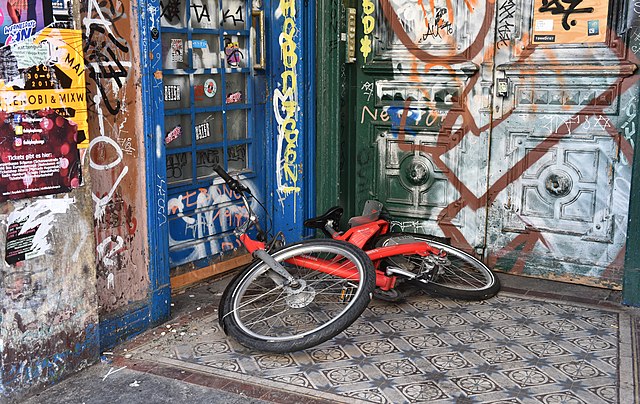Vandalism: Difference between revisions - Wikipedia
 Article Images
Article Images
Content deleted Content added
| (9 intermediate revisions by 8 users not shown) | |||
Line 1: {{short description|Deliberate damage or defacement of an object or structure}} {{
{{pp-move-indef}} {{pp-vandalism|small=yes}} Line 20 ⟶ 19: Historically, vandalism has been justified by painter [[Gustave Courbet]] as destruction of monuments symbolizing "war and conquest". Therefore, it is often done as an expression of contempt, creativity, or both. Courbet's attempt, during the 1871 [[Paris Commune]], to dismantle the [[Place Vendôme|Vendôme column]], a symbol of the past [[Napoleon III of France|Napoleon III]] authoritarian Empire, was one of the most celebrated events of vandalism. [[Friedrich Nietzsche|Nietzsche]] himself would meditate after the Commune on the "fight against culture", taking as example the intentional burning of the [[Tuileries Palace]] on 23 May 1871. "The criminal fight against culture is only the reverse side of a criminal culture" wrote [[Pierre Klossowski|Klossowski]] after quoting Nietzsche.<ref name="klossowski">See [[Pierre Klossowski]], ''Nietzsche and the Vicious Circle'', first Chapter: What is the value of culture if those who are exploited by it destroy it? ''"En sorte qu'il nous faut être bien loin de vouloir, du haut de notre sentiment de nous-mêmes, imputer le crime d'un combat contre la culture exclusivement à ces malheureux.'' Je sais ce que cela veut dire: le combat contre la culture. (...) '' je me campronnai avec une conviction sérieuse à la valeur métaphysique de l'art, lequel ne saurait exister à cause des pauvres gens, mais doit accomplir des missions plus hautes. Mais, en dépit de mon extrême douleur, je n'étais pas en état de jeter la moindre pierre à ces profanateurs qui, pour moi, n'étaient que les suppôts de la culpabilité universelle, sur laquelle il y a beaucoup à méditer!"'' Nietzsche quoted by Klossowski pp. 29–30 French edition, who adds: ''"Le combat criminel contre la culture n'est lui-même que l'envers d'une culture criminelle"'' ("The criminal fight against culture is only the reverse side of a criminal culture")</ref> In a proposal to the International Conference for Unification of Criminal Law held in Madrid in 1933, [[Raphael Lemkin]] envisaged the creation of two new international crimes (delicta [[jus gentium|juris gentium]]): the crime of barbarity, consisting in the extermination of racial, religious, or social collectivities, and the crime of vandalism, consisting in the destruction of cultural and artistic works of these groups.<ref> ==As a crime== [[File:Abgesägte Leiter.jpg|thumb|Vandalized shooting stand in [[Germany]]]] [[File:Vandalismus ve vlaku.jpg|thumb|Vandalized [[seat]] inside a [[Passenger car (rail)|passenger car]] on a [[train]] in the [[ Private citizens commit vandalism when they willfully damage or deface the property of others or the [[commons]]. Some vandalism may qualify as [[culture jamming]] or [[Breaching experiment|sniggling]]: it is thought by some to be artistic in nature even though carried out illegally or without the property owner's permission. Examples include at least some [[graffiti]] art, billboard "liberation", and possibly [[crop circles]]. Criminal vandalism takes many forms. [[Graffiti]] on [[public property]] is common in many [[inner cities]] as part of a [[gang]] culture, where they might be used as territorial markers.<ref>Ley and Cybriwsky 1974.</ref> Line 38 ⟶ 37: In elections, opposing candidates' supporters may engage in "political vandalism"—the act of defacing opponents' political posters, [[bumper sticker]]s, billboards, and other [[street marketing]] material. Although the nature of this material is temporary, its effect can be long-lasting as it may reflect both negatively and positively on the candidate whose material is being vandalized as well as on the presumed candidate whose supporters are engaging in the vandalism. In addition, activists may use the tactic of [[property destruction]]<ref> ===Motives=== Line 57 ⟶ 56: In view of its incivility, [[punishment]] for vandalism can be particularly severe in some countries. In Singapore, for example, a person who attempts to cause or commits an act of vandalism may be liable to [[imprisonment]] for up to three years and may also be punished with [[Caning in Singapore|caning]]. Vandalism in the UK is construed as an [[environmental crime]] and may be punished with an [[ASBO]] (Anti-Social Behaviour Order). In the 1990s, former New York City mayor [[Rudolph Giuliani]] cracked down on "quality of life crimes", including graffiti. NY Parks Commissioner Henry J. Stern described graffiti as "a metaphor for [[urban decay]] perhaps best shown in '[[A Clockwork Orange (film)|A Clockwork Orange]]'" adding that "New York City will not be like that".<ref>{{Cite news| issn = 0362-4331| last = Hicks| first = Jonathan P.| title = Mayor Announces New Assault on Graffiti, Citing Its Toll on City| work = The New York Times| access-date = 8 May 2018| date = 17 November 1994| url = https://www.nytimes.com/1994/11/17/nyregion/mayor-announces-new-assault-on-graffiti-citing-its-toll-on-city.html| archive-date = 9 March 2021| archive-url = https://web.archive.org/web/20210309062159/https://www.nytimes.com/1994/11/17/nyregion/mayor-announces-new-assault-on-graffiti-citing-its-toll-on-city.html| url-status = live}}</ref> ===Cybervandalism=== | |||